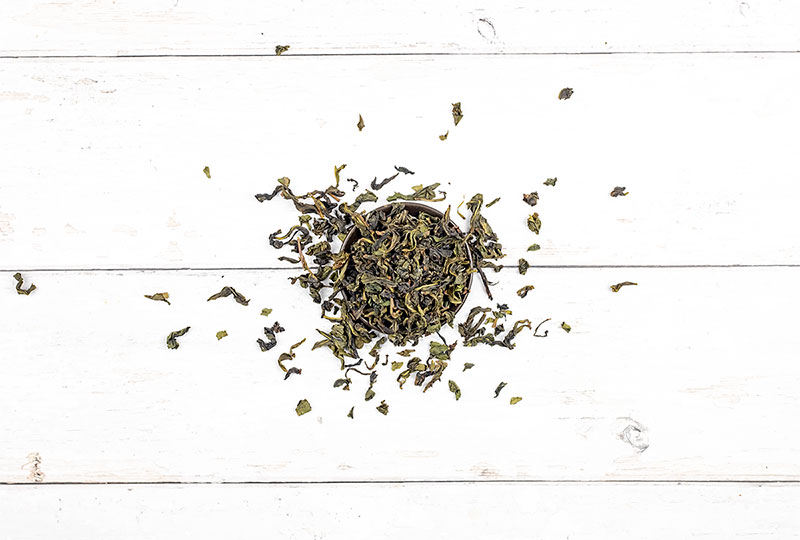Pouchong Tea Guide
If you love greener oolong teas, Pouchong oolong will be like an ultimate treat. This popular Taiwanese tea is unique and highly aromatic, but less known than high mountain oolong. Learn more about Pouchong oolong.
What is Pouchong tea?
Pouchong oolong is a type of lightly oxidized oolong tea from Taiwan. It’s made from Camellia sinensis var sinensis tea leaves. Unlike most Taiwanese oolongs, Pouchong has twisted leaves. It’s less oxidized than many oolong teas, usually around 10%. This means that Pouchong tea will be very similar in aroma, flavor and appearance to green tea. However, there will be a huge difference. In fact, Pouchong is one of those teas you can recognize immediately. It has a very bright beautifully twisted leaves, much bigger than green teas, and an intense floral note, different from vegetal, grassy, toasty or smoky green teas.
Pouchong vs baozhong tea?
Words Baozhong and Pouchong are representing the same tea. Baozhong is a newer way of romanization for Chinese characters包種(bao zhong), literally meaning „the wrapped kind“. Most specialized tea shops selling only Taiwanese tea will use the word baozhong, rather than pouching. Baozhong can be made from different tea cultivars with the most common one being qing xin – or green heart. Other cultivars such as siji chun can be used too.
Tea Origins
Today, Baozhong tea represents Taipei, Taiwan, but it was originally produced in Fujian, Mainland China. Baozhong was always lightly oxidized and usually wrapped into special deckle paper. That’s why it was called “the wrapped type”. About 150 years ago it was brough to Taiwan by a tea merchant Fu-Yuan Wu [1]. First it was produced in Rueifang district, but today, the best Baozhong tea is produced in Wenshan, Taipei. Sometimes, the name Wenshan Baozhong may be used for tea that’s not made in Wenshan, but some other areas. However, baozhong teas coming from important producing areas, such as Shiding or Pinglin district, will always have the source in its name too. Today, this type of tea is produced by some Japanese tea farmers too.
Tea Taste
Baozhong oolong has a remarkable flavor. It is intense, creamy, with light green, floral and melon notes and no bitterness at all. Leaves are beautiful, long and twisted, with a very pretty turtle green color, much bigger than green tea leaves. The flavor of baozhong tea is similar to some gao shan or high mountain oolong teas. However, it will have more simplicity and more playfulness than elegant gao shan types, and it will offer fewer infusions. Furthermore, unlike gao shan teas, baozhong is grown on much lower altitudes. Although highly aromatic, Baozhong is a gentle tea and a wonderful type for daily drinking. This type is sometimes scented with flowers.
Potential Health Benefits
Pouchong tea is a lightly semi-oxidized oolong tea. It may provide benefit similar to green tea. Pouchong contains amino acids, chlorophyl, catechins and other compounds. Studies say that oolong teas may increase fat oxidation and support weight loss [2], reduce the glucose levels in people who have Type 2 diabetes [3], help fight cancers [4], and provide a better free radical scavenging activity than black tea [5]. Find out what are the 15 most important health benefits of oolong tea here.
Caffeine Content
Pouchong tea is an oolong tea. All oolong teas naturally contain caffeine. However, the way of growing, harvesting, producing, steep time and even storing tea will all have an influence on caffeine content. It will usually have the same caffeine content as gao shan teas, and usually less than many other oolong teas, for example, Red Robe oolong. Expect about 20-30 mg of caffeine per cup of Baozhong oolong. This amount may, however, be lower or higher. To reduce the caffeine content, use fewer leaves, shorter steeping time, and wash the leaves with one quick infusion that you will discard.
How to Make Pouchong Tea
Baozhong tea is incredibly easy to brew. Unlike green teas is will be very forgiving to brewing mistakes, and it won’t require much patience. Even though it’s not demanding, it will offer you a very aromatic cup with zero bitterness. To make a perfect cup of Baozhong tea always use freshly boiled spring water. Bring water to a boil, preheat your teaware by pouring hot water in and out. Allow boiled water to cool down to 194°F. Use about 3-5 grams of tea leaves per cup of water and steep for 2 minutes. Oversteeping will influence the flavor, making it more intense and less complex, but it won’t cause bitterness. Alternatively, use a proper gong-fu brewing technique to enjoy all hidden and delicate flavor notes.
Baozhong tea has very large leaves, so teapot or a brewing basket will be the best utensils for brewing this tea. Tea infusers may not be big enough to hold the leaves or allow them to expand fully, and paper tea filters may influence the flavor of this tea.
Where to Buy
Baozhong oolong is available from many specialized Taiwanese tea shops. It sometimes available in supermarkets too. Baozhong is rarely, if ever, available in tea bags.
Disclaimer: This article is for informational purposes only. It’s not intended to replace medical advice, diagnosis, or treatment. Every person is different and may react to different herbs and teas differently. Never use teas or herbs to treat serious medical conditions on your own. Always seek professional medical advice before choosing home remedies.
References:
[1] http://library.taiwanschoolnet.org/gsh2009/gsh5968/the%20origins%20of%20baozhong%20tea.html
[2] https://academic.oup.com/jn/article/131/11/2848/4686734
[3] https://care.diabetesjournals.org/content/26/6/1714
[4] https://www.researchgate.net/publication/14529398_Relationship_between_antimutagenic_and_major_components_of_various_teas
[5] https://link.springer.com/article/10.1007/s00217-017-2986-z



